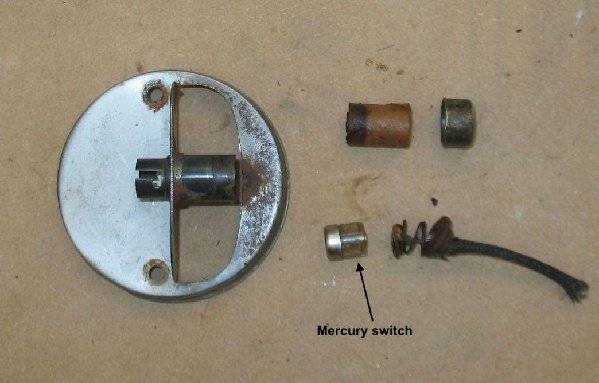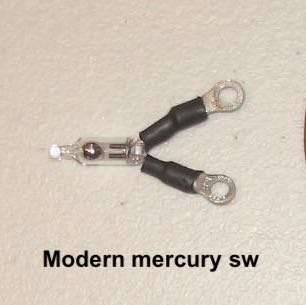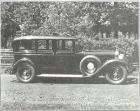|
Clock Light Mystery
|
||||
|---|---|---|---|---|
|
Home away from home
|
When I got my '39 Six, the glass clock face was broken. I was able to find one online and I sent them both to Smith's Classic Clocks and was able to get 'one good one' out of the two.
The 'mystery' question stems from the light on the back of the clock. Not to be confused with the internal illumination light that plugs into the hole in the top of the clock's back, which is wired to the light switch. I'm referencing the small one that is mounted on the back housing. It looks like it is meant as a 'map light'. Problem is, the light is wired together with the power feed for the clock. Both clocks were wired the same way and while both bulbs were good, neither of them came on when hooked up to power. AND, if they did, because the clock power is constant and not ignition-switched, the light would drain the battery. While neither light has current getting through to the bulb, both socket bodies have a distinctive rattle to them. Has anybody ever come up against this before?? Could these little light sockets have vertical/horizontal gravity switches in them in 1939?? Can they be taken apart and fixed? Or, are they available ANYWHERE?? I would dearly like to get this resolved and back to factory if possible. I cannot see how the sockets come apart - does anyone know the answer??
Posted on: 2017/10/12 18:17
|
|||
|
'If you think you can, or you think you can't - you're right!' Henry Ford.
1939 Packard Six, Model 1700 |
||||
|
||||
|
Re: Clock Light Mystery
|
||||
|---|---|---|---|---|
|
Home away from home
|
Thank you Howard. I have always given Packard a lot of credit for innovative ideas and design, but I have to say, I am surprised this was available in '39. I notice in the picture of the disassembled switch, that the end cap has been separated from the socket body. Do you know if this is soldered or just pressed together? I tried heating one of my pair up with a micro-torch, and pulling it with a pair of pliers but couldn't get the cap to come off. Any idea how to remove it?? Chris.
Posted on: 2017/10/12 19:34
|
|||
|
'If you think you can, or you think you can't - you're right!' Henry Ford.
1939 Packard Six, Model 1700 |
||||
|
||||
|
Re: Clock Light Mystery
|
||||
|---|---|---|---|---|
|
Forum Ambassador
|
I honestly don't know about the glovebox cap because I haven't taken one apart. The trunk cap was just pressed on and came off relatively easy with use of pliers and a twist as I pulled.
Looking at the 47 version it appears to be the same as the trunk. If the pliers don't work, since the hood and socket assy is riveted on the clock back plate, perhaps removing the clock plate and supporting it and the lamp assy in such a fashion no stress was applied to the rivets you could use a pin punch and a few gentle taps around the edge of the cap to persuade it off. EDIT: If you get it off maybe post a photo with dimensions of the switch -- diameter and length. I think it might be possible to make a rolling ball switch that would fit in the space. If I can still find my old trunk switch I might give it a try. If it works then it should be able to be done in different sizes.
Posted on: 2017/10/12 19:52
|
|||
|
Howard
|
||||
|
||||
|
Re: Clock Light Mystery
|
||||
|---|---|---|---|---|
|
Home away from home
|
Guys,
For what it's worth, my 39 Six Borg clock had (and still has) a switch made up of a metal ball that rolls against the two light contacts. Delicate and not too reliable, even after I cleaned the whole think up and removed the corrosion. Pat
Posted on: 2017/10/12 21:14
|
|||
|
||||
|
Re: Clock Light Mystery
|
||||
|---|---|---|---|---|
|
Forum Ambassador
|
Interesting. That would explain the rattle Chris heard. They used mercury on the later cars -- at least on the trunk -- so assumed glovebox was the same. Did the end cap press on and then come off with a pull and twist like I described for the trunk light? Was the ball and contacts steel or brass and do you remember the approx size of the ball?
There is a product one of my former co-workers told me about that he says lubes, cleans and protects electrical contacts better than ordinary contact cleaner. I haven't tried it yet but wonder if anyone here has. I am going to order a can from Amazon but if it works as advertised it might be a way to make the ball switches work better and last longer after a cleaning.corrosionx.com/electronics.html
Posted on: 2017/10/12 21:19
|
|||
|
Howard
|
||||
|
||||
|
Re: Clock Light Mystery
|
||||
|---|---|---|---|---|
|
Home away from home
|
Pat, can I ask you how you got the end cap off the socket body on your clock??? Is it soldered? My thought was to get it apart and 'fuse' the 'ball contacts' and then put a nice little inline rotary switch in the wire so it could be used.
Thanks for responding. Chris
Posted on: 2017/10/13 10:43
|
|||
|
'If you think you can, or you think you can't - you're right!' Henry Ford.
1939 Packard Six, Model 1700 |
||||
|
||||

 (51.83 KB)
(51.83 KB)








